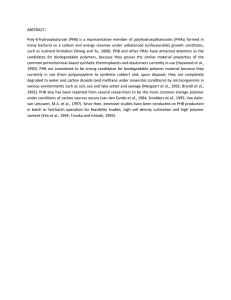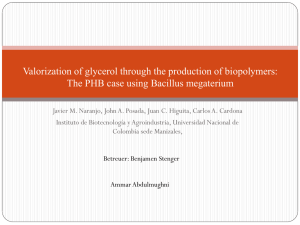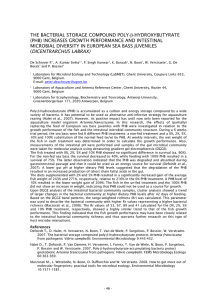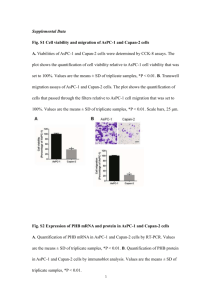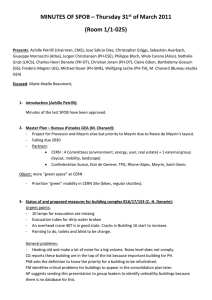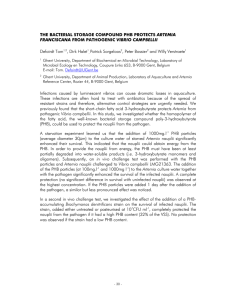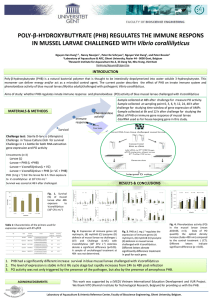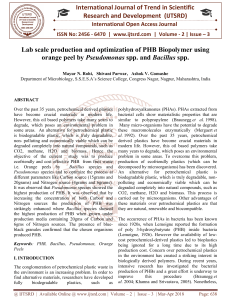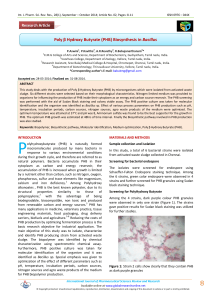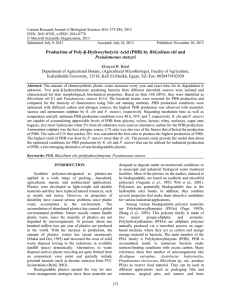Current Research Journal of Biological Sciences 1(2): 23-26, 2009 ISSN: 2041-0778
advertisement
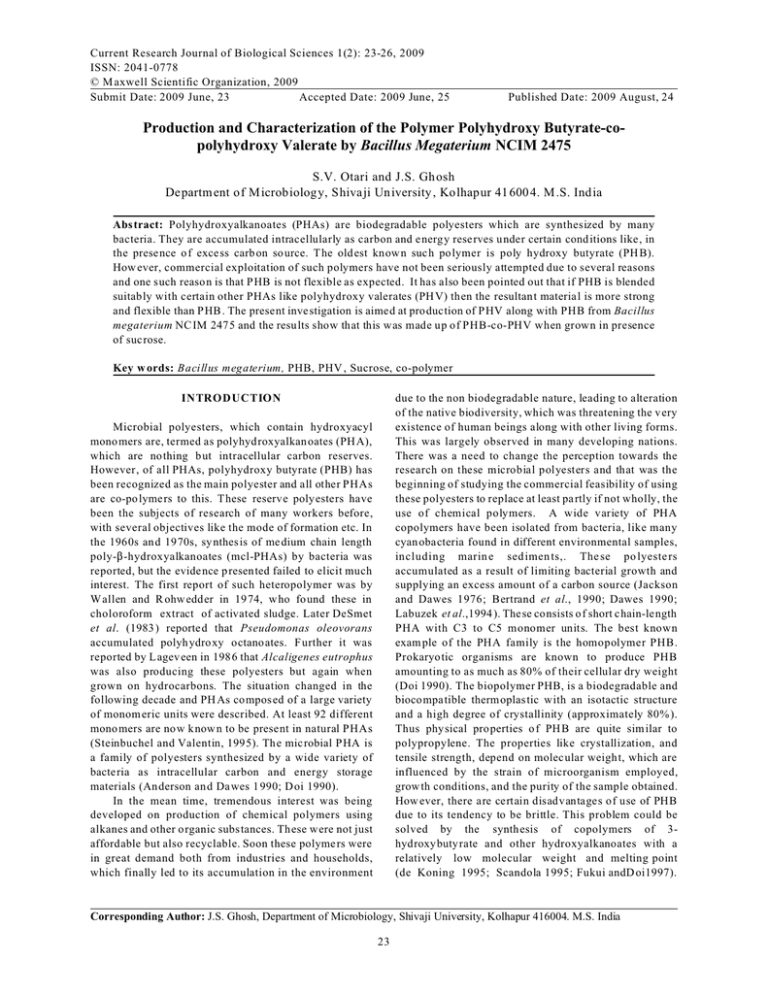
Current Research Journal of Biological Sciences 1(2): 23-26, 2009 ISSN: 2041-0778 © M axwell Scientific Organization, 2009 Submit Date: 2009 June, 23 Accepted Date: 2009 June, 25 Published Date: 2009 August, 24 Production and Characterization of the Polymer Polyhydroxy Butyrate-copolyhydroxy Valerate by Bacillus Megaterium NCIM 2475 S.V. Otari and J.S. Ghosh Departm ent of Microbiolog y, Shivaji University , Kolhapur 41 600 4. M .S. Ind ia Abstract: Polyhydroxyalkanoates (PHAs) are biodegradable polyesters which are synthesized by many bacteria. They are accumulated intracellularly as carbon and energy reserves under certain cond itions like, in the presence o f excess carb on so urce. T he old est known such polymer is poly hydroxy butyrate (PH B). How ever, commercial exploitation of such polymers have not been seriously attempted due to several reasons and one such reason is that P HB is not flexible as expected. It has also been pointed out that if PHB is blended suitably with certain other PHAs like polyhydroxy valerates (PHV) then the resultan t material is more strong and flexible than P HB . The present investigation is aimed at production of P HV along with PHB from Bacillus megaterium NC IM 2475 and the resu lts show that this was made up of PHB-co-PHV when grown in presence of sucrose. Key w ords: Bacillus megaterium, PHB, PHV , Sucrose, co-polymer due to the non biodegradable nature, leading to alteration of the native biodiversity, which was threatening the very existence of human beings along with other living forms. This was largely observed in many developing nations. There was a need to change the perception towards the research on these microbial polyesters and that was the beginning of studying the commercial feasibility of using these polyesters to replace at least pa rtly if not wholly, the use of chemical polymers. A wide variety of PHA copolymers have been isolated from bacteria, like many cyan obacteria found in different environmental samples, including marin e sed imen ts,. The se po lyeste rs accumulated as a result of limiting bacterial growth and supplying an excess amount of a carbon source (Jackson and Dawes 1976; Bertrand et al., 1990; Dawes 1990; Labuzek et al.,1994 ). These consists of short chain-length PHA with C3 to C5 monomer units. The best known exam ple of the PHA family is the homopolymer PHB. Prokaryotic organisms are known to produce PHB amounting to as much as 80% of their cellular dry weight (Doi 1990). The biopolymer PHB, is a biodegradable and bioco mpa tible thermoplastic with an isotactic structure and a high degree of crystallinity (approximately 80% ). Thus physical pro perties o f PHB are quite sim ilar to polypropylene. The properties like crystallization, and tensile strength, depend on molecular weigh t, which are influenced by the strain of microorganism employed, grow th conditions, and the purity of the sample obtained. How ever, there are certain disadvantages of use of PHB due to its tendency to be brittle. This problem could be solved by the synthesis of copolymers of 3hydroxybutyrate and other hydroxyalkanoates with a relatively low molecular weight and melting point (de Koning 1995; Scandola 1995; Fukui andD oi1997). INTRODUCTION Microbial polyesters, which contain hydroxyacyl mono mers are, termed as polyhyd roxyalkan oates (PH A), which are nothing b ut intracellular carbon reserves. However, of all PHAs, polyhydroxy butyrate (PHB) has been recognized as the main polyester and all other PHAs are co-po lyme rs to this. These reserve poly esters have been the subjects of research of many workers before, with several objectives like the mode of formation etc. In the 1960s and 1970s, sy nthesis of me dium chain length poly-$-hydroxyalkanoates (mcl-PHAs) by bacteria was reported, but the evidence p resented failed to elicit much interest. The first report of such heteropolymer was by W allen and R ohw edder in 1974, w ho found these in choloroform extract of activated sludge. Later DeSmet et al. (1983 ) reported that Pseudomonas oleovorans accumulated polyh ydroxy octano ates. Further it was reported by Lagev een in 1986 that Alcaligenes eutrophus was also producing these polyesters but again when grown on hydrocarbons. The situation changed in the following decade and PH As co mposed of a large variety of monom eric units were described. At least 92 different mono mers are now know n to be present in natural PHAs (Steinbuchel and Valentin, 1995). The microbial P HA is a family of polyesters synthesized by a wide variety of bacteria as intracellular carbon and energy storage materials (An derson an d Dawes 1 990; D oi 1990). In the mean time, tremendous interest was being developed on production of chemical polymers using alkanes and other organic substances. These were not just affordable but also recyclable. Soon these polyme rs were in great demand both from industries and households, which finally led to its accumulation in the environment Corresponding Author: J.S. Ghosh, Department of Microbiology, Shivaji University, Kolhapur 416004. M.S. India 23 Curr. Res. J. Biol. Sci.,1(2): 23-26, 2009 One such co-polymer used was polyhydroxy valerate (PHV ). Major advantage of the PHB-PHV copolymer over the PHB homopolymer is that the copolymer has a lower flexural modulus or level of crystallinity, which makes it tougher and more flexible. Materials with high PHV content tend to be soft and tough, while materials with low PHV content are hard and brittle. High molecular weight of PHB is more useful and desirable for industrial applications. The molecular weight of PHB can be reduced during the polymer processing step (Bourque et al., 1992). In addition to the costs of maintaining pure cultures and the high costs of organic substrates, polyme r recovery process is another factor that contributes to the high overall cost of PHA production . Seve ral wo rkers in this field have tried to isolate the g enes responsible for such PHA in bacteria (Shamala et al., 2003 ) and h ave tried to transfer these in an eukaryote like yeast which can grow on a far less expensive substrate and yet produce these PHAs in significant quantity (Ashraf et al., 2007, Desouky and Haleem, 2009). In this study, an attempt has been made to explore the possibility of reducing the cost of substrate by using less expensive substrate like sucrose which is easily available as molasses from the sugar industry. Fig. 1: The growth pattern of Bacillus me gate rium NC IM 2475 on the above mentioned medium was obtained using the same specified incubation time and other conditions as specified MATERIALS AND METHODS The Bacillus megaterium NCIM 2475 culture was grown in liquid medium containing 2% sucrose along with MgSO 4 :0.4%, CaCl2 :0.11% ,Na 2 HPO 4 :3.7 % , (NH4) 2 SO 4 :0.200% K2 HPO 4 : 2.0 % and Ammonium ferric citrate : 0.600 %. The flasks were incubated on shaker at 300 C for 72-96 hrs with an agitation rate of 125 rpm. First of all the growth pattern of this microorganism was recorded as shown in figure 1. Polymer granules were harvested as per the method of Williamson and Wilkinson, 1958. The quantitation of PHAs was carried out by method of Kansiz et al, 2000. This was then analyzed by FTIR, NMR and UV spectroscopy. The results are shown in following Figures 2, 3 and 4. Fig 2 : UV Spectroscopy was done between the range of 220nm and 330nm groups, followed by a peak at 1732.13 which shows the presence of –C=O and then a distinct peak at 1251.84 which is the –C-O. Now this peak should have been at 1280 which w ould h ave indicated that the –C-O is in stretched form which would have meant that the polyesters are all of 3-hydroxy alkanoates. Since it was not so, further analysis w as required to investigate whether there were other hyd roxy alkanoates present. This led to inv estigate the H -N M R spectroscopic data of the compo und. The results from Figure 4 showed that the compound was a polyester of 3-hydroxy butyrate with 3-hydroxy valerate and some amount of 5-hydroxy valerate. The quantitave analysis show ed that PHB co nstituted nearly 10% of the dry weight of the cells, whereas PHV s were barely 2% of the dry weight of the cells at the end of 96th hour of incubation. On the other hand this combination of polyesters was not rigid like PHB alone and could be easily folded and shaped. It is well known that the cells would produce depolymerase enzymes to breakdown PHB which is a reserve energy so urce. Ho wev er, it still remains a puzzle, as to why the cells would produce PHVs as reserve energy source. RESULTS AND DISCUSSION It can be seen from the Figure 1, that Bac illus megaterium NC IM 2475, entered the idiopha se of growth from 8hrs onw ard an d it was further noted that this idiophase continues upto 100 hrs. The polyester granules appeared inside the cell from 8 th hour of growth and was best obtained arou nd 96 hrs. The UV absorption spectrum from Figure 2, shows 2 distinct absorption peaks; one around 230nm and the other around 290nm. The major peak, was however, at 290nm. This indicates that polyester accumulating inside the cell must be of atlea st 2 type s. The FTIR spectroscopic results from Figure 3, shows that the large peak at 2956.97 which represents the –CH 2 24 Curr. Res. J. Biol. Sci.,1(2): 23-26, 2009 Fig 3: Fourier transform infra red (FTIR) spectroscopic results of compound Figure 4: NM R spectra of the compound ACKNOWLEDGEMENT Department of Bioche mistry and Dr. K.D. Sonawane Coordinator, Department of Microbiology for providing all the laboratory facilities towards successful completion of this work. This work is in fact a part of the master’s degree in microbiology of our University. We are very grateful to Professor S.P. Gov indwa r-Professor and Head, 25 Curr. Res. J. Biol. Sci.,1(2): 23-26, 2009 Doi, Y. 1990. M icrobial Polyesters. VCH Publishers, Inc. New York, USA. Fukui, T. and Y. Doi, 1997. Cloning and analysis of PHB-co-3-polyhydroxy hexnoate biosynthesis genes of Aeromonas caviae. J. Bacteriol. 8: 4821-4830. Jackson, F.A. and E .A. D awes, 1976. Regulation of tricarboxylic acid cycle and PHB metabolism in Azotobacter beijerinckii grown under nitrogen or oxygen limitation. J. Gen. Microbiol., 97: 303-312. Kansiz, M., B.J. Helen and M.N. Don, 2000. Quantitative determ ination of biodegradable polymer PHB in a recombinant Escherichia co li strain by use of mid infra-red spectroscopy and multi variative statistics. Appl. Env. Microbiol. 66: 3415-3420. Labuzek, S., I. Radeck a and M. Kowalczuk, 1994. Microbial production of polyhydroxyalkanoates by bacteria from oil wastes. Biol.Sci. 42(2): 121-123. Lageveen, R.G . 1986. Oxidation of aliphatic compound s. Ph.D. Thesis. Univ. Groningen, The N ederlands. Scandola, M., 1995. A review of biodegradable polymers. Can. J. Microbiol. 41: 310-323. Shamala, T.R., A. Chan drashekar, S.V.N. Vijayendra and L. Kshama, 2003. Identification of PHA producing Bacillus spp using polymerase chain reaction. J. Appl. Microbiol. 94: 369-374. Steinb uchel, A. and H. Valentin, 1995. Diversity of bacterial polyhydroxyalkan oic ac ids. FEM S Microbiol. Lett. 128: 219-228 W allen, L.L. and W .K. R ohwedder, 1974. PHA from activated sludge. Environ. Sci. Technol. 8: 576-579. W illiamson, D.H. and J.F. W ilkinson, 1958. The isolation and estimation of poly hydroxylbu tyrate inclusions of Bacillus species. J. Gen. M icrobiol., 19: 198-209. REFERENCES Anderson A.J. and E.A. Dawes, 1990. Occurrence, metabolism, metabolic role, and industrial uses of bacterial polyhydroxyalkanoates. Microbiological Reviews. 54 (4): 450-472. Ashraf T.A., A.M. Desouky, A.E. Haleem , A.Z. Sah ar, A. Amro an d M .S.A. G adallah, 200 7. Genetic engineering of Schizosaccharomyces pombe to produce bacterial PHAs. J. Appl. Sci. Environ. Manage., 11(2): 83-90. Bertrand J.L., B.A. Ramsay J.A. Ramsay and C. Chavarie, 1990. B iosysnthesis of $-polyhydroxy alkanoates by Pseudomonas pseudoflava. Appl. Env iron. M icrobio l., 56(10): 3133 -3138. Bourque D, B. Ouellette, G. Andre and D Groleau, 1992. Production of PHB from methanol: characterization of a new isolate of Methylobacterium extorquens. Appl. Microbiol. Biotechnol. 37: 7-12. Daw es, E.A. 1990. Novel Microbial Polymers: An Introductory Overview. In: Novel Biodegradable Microbial Polymers, Dawes, E.A. (ed.), Kluwer Academic Publishers,The Netherlands, 3-16. De Koning, G., 1995. Physical properties of bacterial poly((R)-3-hydroxy alkanoates). Can . J.Microbio l. 41(1): 303-309. DeSmet M.J., G. Eggink, B. Witholt, J. Kingma and H. Wynberg, 1983. Characterization of intracellular inclusions formed by Pseudomonas oleovorans during grow th on o ctane. J. Bac teriol., 154: 870-878. Desouky, A.M. and A.E. Haleem, 2009. Biosynthesis of polyhydroxyalkanoates in wild type yeasts. Polish J. Microbiol. 58 (1) : 37-41. 26
